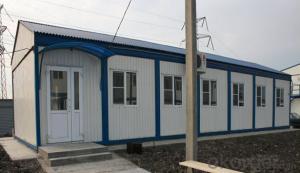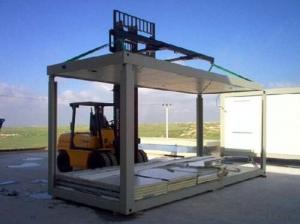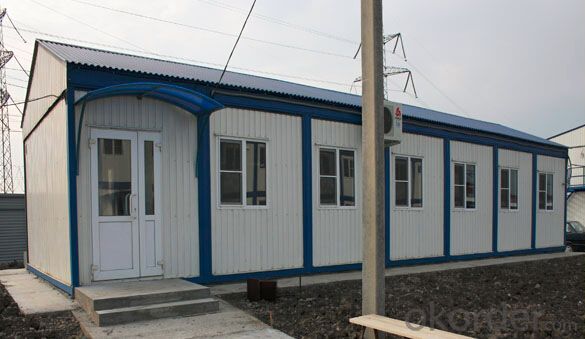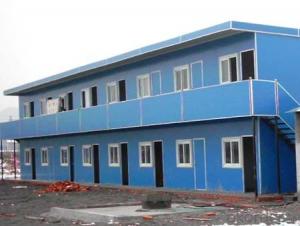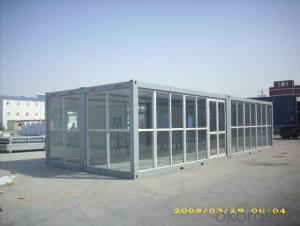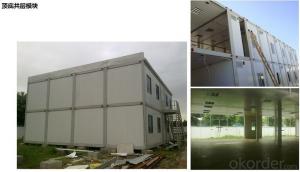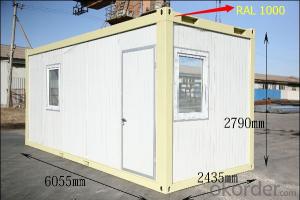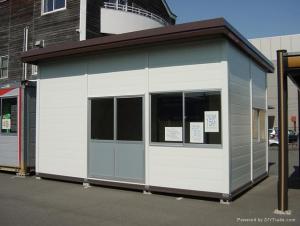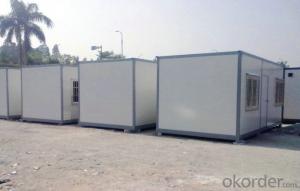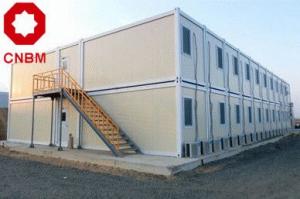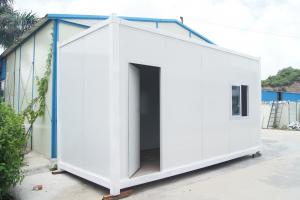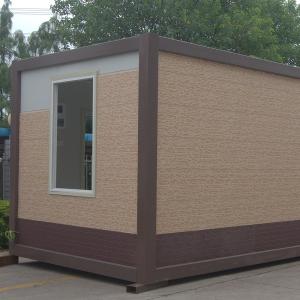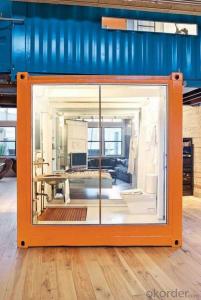Secondary Slope Added Container Houses For Economical Budget Homes
- Loading Port:
- Tianjin
- Payment Terms:
- TT OR LC
- Min Order Qty:
- 100 m²
- Supply Capability:
- 200000 m²/month
OKorder Service Pledge
OKorder Financial Service
You Might Also Like
Secondary slope added container houses for economical budget homes

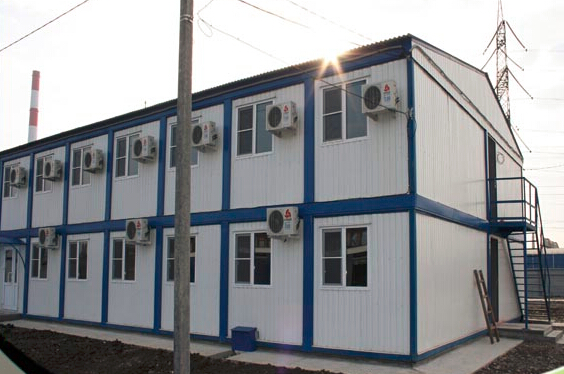
Brief instroduction of structure:
The steel structure is strong and firm, wind resistance capacity>220-280km / h, seismic resistance capacity >grade 8.
Completed galvanized steel frame, anti-rust and especially for seaside and high humidity area.
Time and Labor saving and Easy assembly:
Two skilled workers can finish assembling one standard unit within 3 hours
Flexible combination:
Multiple modular buildings can be easily combined horizontally and vertically.
Wide applications:
Can be used as warehouse, home, villa, toilet, shower, shop, hotel, camp, workshop, office, hospital etc.
Cost-effective and Easy transportation way:
9 units / 40’HQ loading
High mobility:
Completed lifting and easy to move from one site to another site.
Dimension:
10’: 3027x2435x2591/2791mm
20’: 6055x2435x2591/2791mm
30’: 9000x2435x2591/2791mm
40’: 12192x2435x2591/2791mm
Technical Details
Roof: 0.5mm color-bond steel sheet roof
Floor: 18mm plywood board& fiber-cement board+1.5~3.5mm vinyl sheet &15mm bamboo flooring
Window: UPVC double glass tilt& swing window with Alu. Roller shutter
External door: Steel security door
Internal door: UPVC internal door& Aluminum frame sandwich panel door
External wall panel: 50/60/75/100/150mm sandwich wall panel
Internal wall: 50/60/75mm sandwich wall panel
Ceiling: 50mm EPS& rock-wool sandwich ceiling panel
Sanitary: White ceramic
Kitchen: MDF cabinet surface with lacquered paint and bench top with quartz stone
Electrical fittings: Wiring, power point, switch, light, circuit-breaker etc
Gutter: PVC gutter with down pipe.
Photos for materials
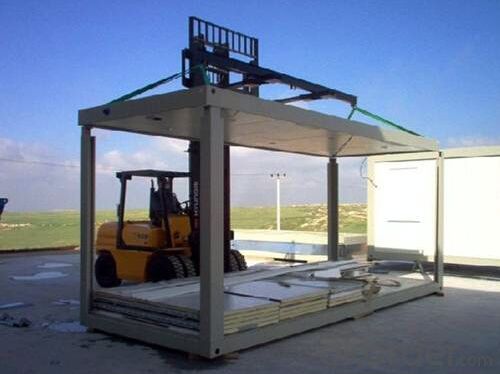

FAQ
Q1: Why buy Materials & Equipment from OKorder.com?
A1: All products offered by OKorder.com are carefully selected from China's most reliable manufacturing enterprises. Through its ISO certifications, OKorder.com adheres to the highest standards and a commitment to supply chain safety and customer satisfaction.
Q2: How do we guarantee the quality of our products?
A2: We have established an advanced quality management system which conducts strict quality tests at every step, from raw materials to the final product. At the same time, we provide extensive follow-up service assurances as required.
Q3: What is the service life of a Prefabricated House?
A3: The life of a prefabricated house is at least double that of a corresponding concrete building.
Q4: Why choose a Prefabricated House?
A4: Prefabricated Homes are built to high aesthetic and architectural standards. Additionally, Prefabricated Houses are more resistant (better earthquake protection) and are not affected by extreme weather events, use eco-friendly materials, and offer excellent insulation and energy efficiency.
Q5: Are Prefabricated Houses safe?
A5: Our houses are completely safe. Advances in the field of prefabricated buildings have reached a point that today Prefabricated Homes are considered safer than traditional homes built with brick. In areas with high seismic activity and in countries prone to extreme weather events residents prefer prefabricated homes for safety reasons.
- Q: Can container houses have rooftop gardens or green features?
- Yes, container houses can have rooftop gardens or green features. The flat rooftop of a container house provides an ideal space to create a garden or incorporate green features such as solar panels, rainwater harvesting systems, or even green roofs. These additions not only enhance the aesthetic appeal of the house but also promote sustainability and environmental benefits.
- Q: Can container houses be designed to have a minimalist interior design?
- Yes, container houses can certainly be designed to have a minimalist interior design. The versatility and simplicity of container structures lend themselves well to minimalist aesthetics. By carefully selecting the materials, colors, and furniture, it is possible to create clean lines, open spaces, and a sense of simplicity within a container house. To achieve a minimalist interior design, it is important to prioritize functionality and declutter the space. This can be done by selecting multipurpose furniture that serves multiple functions and eliminates the need for excessive pieces. Additionally, using built-in storage solutions and concealed cabinets can help keep the space organized and free of visual clutter. In terms of color palette, a minimalist interior design often relies on neutral tones such as white, beige, or gray. These colors create an open and airy atmosphere while allowing the focus to be on the simplicity of the space. However, pops of color can be added through accent pieces or artwork to bring visual interest and personality to the design. Lighting is another crucial element in minimalist design. Natural light should be maximized by incorporating large windows or skylights, as it helps create a sense of openness and connection to the surrounding environment. Additionally, using sleek and minimalistic light fixtures can further enhance the clean and uncluttered look. Ultimately, the key to designing a minimalist interior in a container house lies in the thoughtful selection of materials, furniture, and colors that prioritize simplicity, functionality, and open spaces. With careful planning and attention to detail, container houses can absolutely embody the principles of minimalist design.
- Q: Can container houses be designed to have a skylight or large windows?
- Yes, container houses can be designed to have skylights or large windows. In fact, many architects and designers are now incorporating skylights and large windows into container house designs to maximize natural light and create a sense of spaciousness. Skylights can be installed on the roof of the container, allowing ample sunlight to enter the interior space. Large windows can also be incorporated into the side walls of the container, providing panoramic views and further enhancing the overall aesthetics of the house. Additionally, the use of skylights and large windows can help improve ventilation and reduce the need for artificial lighting during the day, making container houses more energy-efficient and sustainable.
- Q: Can container houses be designed with a modular layout?
- Container houses can certainly have a modular layout, offering one of the main benefits of this type of housing. The modular design allows for convenient customization and flexibility in terms of layout and floor plan. Each shipping container can be viewed as a separate module that can be stacked or rearranged to achieve the desired design. Therefore, container houses can be easily enlarged or downsized by adding or removing containers. Moreover, the modular layout of these houses enables effortless transportation and on-site installation. Ultimately, the modular design opens up infinite possibilities for creating distinctive and practical living spaces with container houses.
- Q: Are container houses suitable for outdoor enthusiasts or nature lovers?
- Container houses are a great fit for those who love the outdoors and nature. These homes are unique and sustainable, allowing residents to fully embrace nature by seamlessly blending in with their surroundings. Container houses can be constructed in remote areas, such as beaches, mountains, or deep forests, offering access to breathtaking landscapes and outdoor activities. Furthermore, the use of eco-friendly materials in building container houses aligns with the values of nature lovers and outdoor enthusiasts who prioritize sustainability. These homes can also be designed with features like large windows, outdoor decks, and open floor plans to maximize natural light and provide stunning views of the environment. In conclusion, container houses provide the perfect combination of modern living and a strong connection to the natural world, making them an excellent choice for outdoor enthusiasts and nature lovers.
- Q: Can container houses be designed to blend with the surrounding environment?
- Yes, container houses can be designed to blend with the surrounding environment. With proper planning and design, container houses can be customized to harmonize with the natural landscape or complement the existing architectural style of the area. Here are a few ways container houses can be designed to blend seamlessly with their surroundings: 1. Material selection: Opting for natural and sustainable materials, such as wood or stone finishes, can help the container house blend with the natural environment. These materials can be used for cladding or as accents to soften the industrial look of the containers. 2. Color palette: Choosing earthy tones, muted colors, or shades that match the surroundings can make the container house visually blend into the environment. This can be achieved through painting, using natural pigments, or employing camouflage techniques like incorporating plants or green roofs. 3. Landscape integration: Incorporating landscaping elements around the container house can enhance its integration with the surroundings. This can include planting trees, shrubs, or creating gardens that complement the natural features of the area. 4. Design adaptation: Modifying the container house's design to mimic the local architectural style can help it blend better with the surrounding environment. This could involve adding traditional elements, such as pitched roofs, porches, or balconies, to create a harmonious integration with nearby structures. 5. Orientation and placement: Properly positioning the container house on the site can maximize its relationship with the surrounding environment. Orienting windows and openings to capture scenic views or natural sunlight can create a stronger connection between the house and its surroundings. Ultimately, the design possibilities for container houses are endless, and with thoughtful planning, they can be tailored to blend seamlessly with their surroundings. By utilizing appropriate materials, colors, landscaping, and design adaptations, container houses can become an integral part of any environment while still maintaining their unique and sustainable character.
- Q: Are container houses suitable for artists' studios or workshops?
- Yes, container houses can be suitable for artists' studios or workshops. They offer cost-effective and versatile spaces that can be customized to meet the specific needs of artists. Container houses provide ample natural light, flexible layouts, and can be easily modified to include features like large windows, skylights, or additional storage. Additionally, their portability allows artists to easily relocate their studios if desired.
- Q: Are container houses suitable for single individuals?
- Yes, container houses can be suitable for single individuals. Container houses are compact and can be designed to meet the specific needs and preferences of an individual. They provide a cozy and private living space for a single person, with all the necessary amenities. Additionally, container houses are often more affordable than traditional houses, making them an attractive option for individuals who want to live on their own without breaking the bank. They can be easily customized and adapted to create a comfortable living environment, with options for insulation, ventilation, and efficient use of space. Container houses also offer the advantage of being portable, allowing individuals to move their home to different locations if desired. Overall, container houses can be an excellent choice for single individuals looking for a unique and cost-effective housing solution.
- Q: How do container houses handle natural light?
- There are multiple ways in which container houses manage natural light. To begin with, they can utilize large windows or glass doors to allow abundant sunlight into the space. These windows are strategically positioned to optimize the amount of natural light that enters the house. Furthermore, skylights can be installed on the roof of container houses to bring in even more natural light. Another technique employed by container houses to handle natural light is the use of light-colored interior finishes and materials. Light-colored walls, ceilings, and floors reflect and enhance natural light, resulting in a brighter and more spacious atmosphere. Lastly, container houses can integrate various shading devices like blinds or curtains to regulate the amount of sunlight that enters the house and prevent overheating during hot summer months. All in all, container houses prioritize the utilization of natural light to create a welcoming and well-lit living environment.
- Q: Are container houses suitable for remote locations?
- Yes, container houses are suitable for remote locations. They are easy to transport and can be assembled quickly, making them ideal for areas with limited resources and infrastructure. Additionally, container houses are durable and weather-resistant, making them well-suited for harsh environments commonly found in remote locations.
Send your message to us
Secondary Slope Added Container Houses For Economical Budget Homes
- Loading Port:
- Tianjin
- Payment Terms:
- TT OR LC
- Min Order Qty:
- 100 m²
- Supply Capability:
- 200000 m²/month
OKorder Service Pledge
OKorder Financial Service
Similar products
Hot products
Hot Searches
Related keywords
